It should be noted that the central channel is responsible for the realistic reproduction of the characters ’speech and impressive sound effects. If you decide to assemble a home theater that would provide you with truly high-quality sound, you need to purchase the best center channel speaker. A separate cabinet loudspeaker is perceived as a more powerful central channel because users rarely prefer the inbuilt center (due to the low functional characteristics and weak sound production).
The information that is transmitted to the central channel is not only dialogs but also more than half of the total sound reproduced by the home theater system. An attempt to abandon the use of a central speaker system will lead to significant distortions of the surrounding sound picture and the loss of its naturalness. Before making a final choice, it’s recommended to get acquainted with the reviews and buyer’s guide tips, which provide answers to popular questions and allow you to choose the convenient unit for each specific case.
Center Channel Speaker Reviews
Sony SSCS8
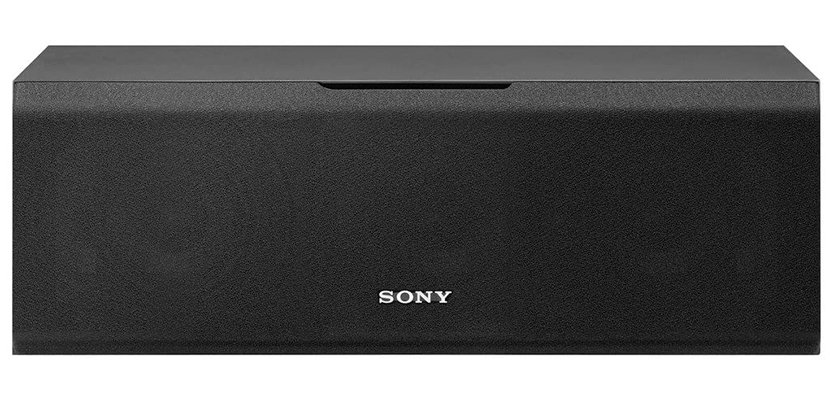
This passive 2-way Sony center speaker has a damped housing made of MDF and a removable protective mesh. It closes the entire front panel of the speaker system, making it inconspicuous in the interior. The SSCS8 can be installed on a rack or shelf using a special stand. This unit can provide the 55Hz – 25kHz frequency response that brings the sound clearness. The 1-inch soft dome is covered with a mesh that protects it from accidental damage. Due to the 6-Ohm impedance, the unit reproduces clear and natural sound and implies minimal distortion. The center channel speaker can easily be paired with other speakers of the same power level outage (145W). A pair of transparent plastic binding posts is used for the amplifier connection. I really like that the device produces high-quality sound (without noises and creaks) on different volume levels.
Pros
- The heights are crystal clear, while the bass is deep and the sound goes exactly from the middle part.
- The cabinet vibration is barely noticeable even while working at a high volume.
- It has a dual-layer mica fortified woofer for an amazing bass response getting.
Cons
- Sounds output drops by around 35Hz.
- If the Auto switch is on, the subwoofer switches off almost every 10 minutes.
Polk Audio CS10
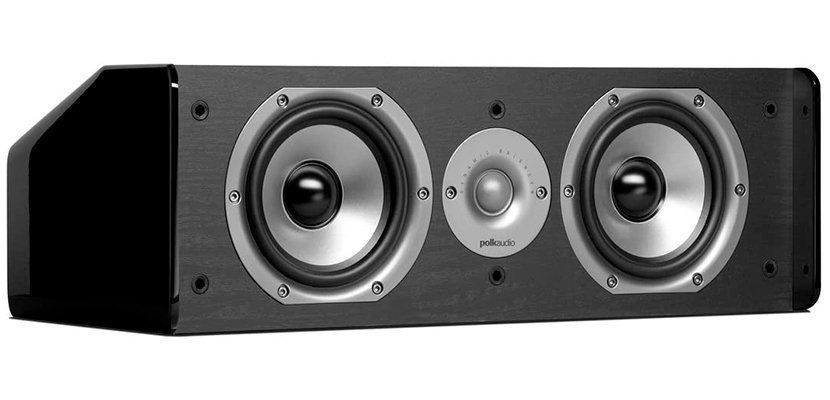
The passive 2-way Polk Audio center speaker has an upscale design as side panels are coated with black varnish, while the remaining surfaces of the speaker have black wood grain finish. An acoustically transparent protective net allows you to almost completely hide the Polk CS10 in the interior, which gives the speaker a versatile appearance. The speaker system is equipped with two relatively small bass speakers with a diameter of 5.25 inches, which reproduce percussion and rather a deep bass. This is achieved due to the exact coordination of the speaker and body frame parameters, as well as damping of the entire construction. The high-frequency radiator is equipped with a 1-inch silk dome and has the Dynamic Balance drivers to obtain pure and detailed sound in a wide frequency range. Its sensitivity is 91dB which allows loud music enjoying without sound distortion. The frequency response is 63Hz – 24kHz so the speaker system reproduces pleasant high-quality sound for human ears. Its impedance is 8 Ohms, being fully compatible with weaker speakers. The Polk Audio CS10 is equipped with input screw terminals with gold-plated contacts, to which you can hook up any speaker connectors. When the stand for speaker is low, the Polk Audio product can be turned 180 degrees and set so that it will be directed at an angle to the audience.
Pros
- The inner construction eliminates internal resonance and doesn’t produce vibration.
- It’s timbre-matched to TSi Series so all the system speakers have the same tonal qualities.
- The unit has a reflex port design. The closer you place it to a wall the better bass response you will get.
Cons
- Most deep voices are understandable but some high pitched voices are not pleasant aurally and are not crisp.
- It gets hot quickly that may adversely affect the duration of the device’s life.
Video Polk Audio CS10
Micca MB42X-C
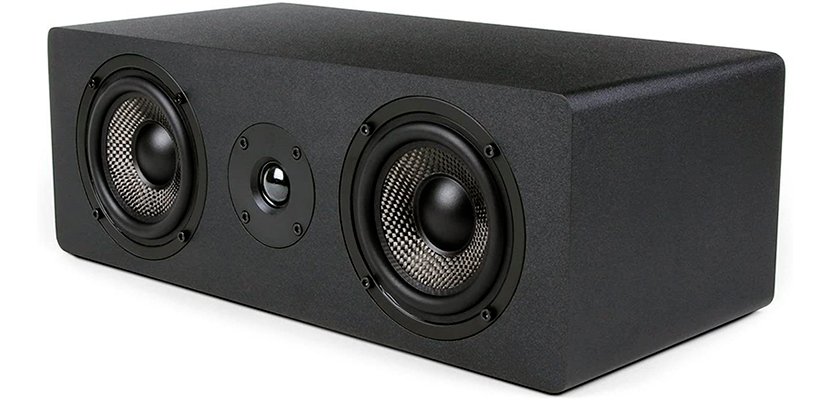
The passive unit is not self-powered, so don’t forget to use an amplifier or a receiver. It has a solid assembly quality, black color design (suitable for most interiors), and protective magnetic grilles that uphold the inner elements form the damages and dust. The Micca MB42X-C is complemented with a 4-inch woven carbon fiber woofer that was designed to produce a well-defined bass. Its 0.75-inch silk dome tweeter helps reproduce frequencies of 60Hz – 20kHz and gets the smooth treble. The crossover design consists of nine elements, which allow getting a dynamic sound signature. It’s easy to notice the balance between the crisp sound and harshness of all the music tracks because the MB42X-C has a high sensitivity (85dB) and conveys all the specifics of different genres of music. The 4-Ohm impedance is enough to get greatly-defined highs and lows. Pay attention that if you especially like the bass-driven genres, it probably will be hard to perceive the Micca MB42X-C as the best center speaker. Such hard sounds are good, but you may hear the lack of deepness intermittently.
Pros
- It requires only 6 inches of clearance from the back wall in order to get a good sound.
- The enhanced tonal balance is pleasant to the ear and does not create any sound vibrations.
- It can be placed vertically and horizontally, the sound quality will stay the same regardless of the position.
Cons
- There are no bass/treble controls.
- It’s not convenient that the power switch and volume controls are placed on the rear side.
Video Micca MB42X-C
Polk Audio T30
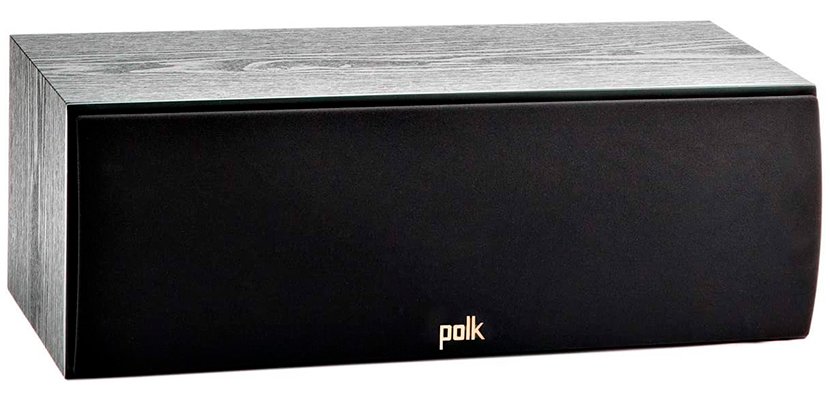
The proprietary Dynamic Balance technology is used in the Polk T30 development. Its laser visualization method makes possible to minimize spurious resonances of emitter membranes. The Dynamic Balance makes it possible to expand the frequency range of the drivers, provide wide dispersion, and reduce distortion. Its design is acoustically inert and the body frame is made of MDF, which makes it easy to get a rich and detailed sound without the muffled and rattled noise. Some people even consider the unit as the best center channel speaker for dialogue, as it transmits clear voices and even hearable whispering or breathing.
Its 1-inch silk dome tweeter and a high-performance bass port make it simple to get a crystal clear dialogs and realistic sound. There are two 5.25-inch drivers with composite diffusers that have a long stroke. On the case’s rear panel, there are a port of the bass reflex and two gold-plated screw terminals for the speaker cable connection. Its frequency response is rather decent (35Hz – 20kHz). This 2-way passive unit is versatile, as it delivers incredible sound and concert-quality music in a classic style. The Polk Audio T30 sensitivity is ordinary (90dB) and the 6-Ohm impedance is a good indicator that lets get a clear sound.
Pros
- The model can be easily paired with most modern AV-receivers, processors, and amplifiers.
- You can use the self-adhesive rubber feet that come with the unit in order to prevent the speaker from sliding over the surface.
- All the emitters have a wide directive pattern, which makes it possible to get a large coverage area with sound waves and enjoy an open surround sound.
Cons
- It gets hot easily, so it’s better to make some pauses while working.
- The removable fabric grill has some holes and doesn’t protect the dynamics from external mechanical damages.
Klipsch RP-450C
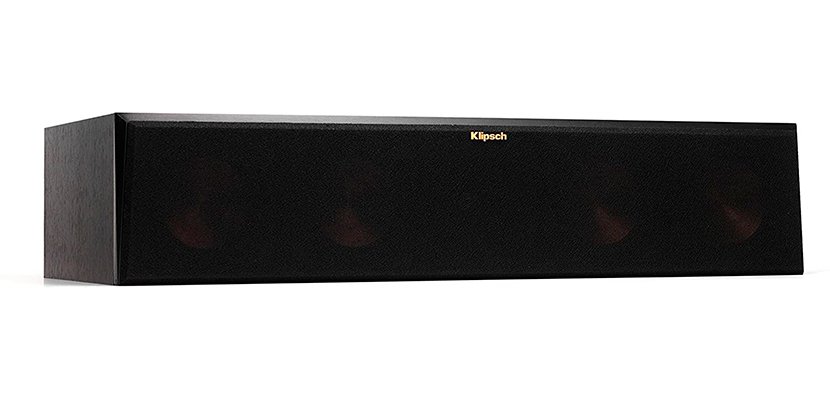
This passive 2-way central speaker has four cerametallic woofers with a diameter of 5.25 inches and a horn tweeter, which accurately convey both dialogs and explosive special effects. Due to the rubber polymer construction created by injection molding, it significantly reduces the noise level. Moreover, it improves detail in the high-frequency spectrum and creates a clean and natural sound. The tweeter in the RP-450C has an improved design – its dome is equipped with the patented Linear Travel Suspension, so it can move along a linear path, keeping a strictly horizontal position. This reduces the distortion of the sound, which becomes more detailed.
The RP-450C body frame is made of thick MDF, covered with the polymer veneer. It has internal ties to damp the stray resonances of the walls. The safety level is high as a removable magnetic grill on the front panel protects the dynamics. Two pairs of reliable gold-plated screw terminals are provided to connect the speaker and the amplifier. Some people can probably call the Klipsch RP-450C the best center speaker, as its frequency response (58Hz – 25kHz) allows hearing even the barely noticeable sounds. The unit’s impedance is one of the highest (8 Ohms) and the sensitivity (97dB) is enough for extreme details perceiving.
Pros
- Redesigned (90×90) Tractrix horn improves high-frequency response and extension. At the same time, it enhances dynamics and imaging.
- It supports Dolby Atmos technology.
- The device can perform the sounds on the highest volume without noise and breakup.
Cons
- The unit is rather large (14.6 x 31.2 x 6.9 inches) so it might be hard to find a place for it.
- There is a rear port, which is hard to reach, especially after the speaker’s close to wall installation.
Video Klipsch RP-450C
Polk Audio Blackstone TL1
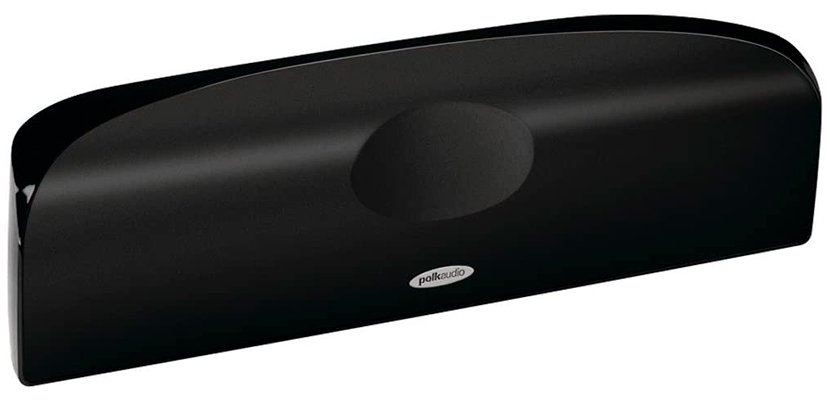
This 2-way slim center channel speaker has a unique curved design that creates the condition for correct alignment of the tweeter’s center. Its body frame is made of gloss plastic metal and the assembly quality is solid, as all the fragments do not creak and are securely attached. The rear port is responsible for bass extension and boosts the audio when the unit is mounted on the wall or placed on a shelf. Its mid-bass is also aligned and leads to distortions and diffractions reducing. The Polk product is amended by the two 2.5-inch drivers, injection-molded cones, and a 0.5-inch silk dome tweeter, which allows getting a detailed and classic sound quality with smooth downs and highs.
The speaker’s nominal impedance is 8 Ohms, while the sensitivity level (89dB) creates the conditions for really loud music getting without sound hindrances. Its frequency response varies between 120Hz and 22kHz, so the sound is transmitted with a high degree of accuracy. The user can’t control the volume on the speaker itself, as the Polk Audio Blackstone TL1 is a passive one and can be managed only via an amplifier or receiver.
Pros
- The bass is complemented with a patented Power Port phase-inverter, which has low acoustic noise and high efficiency.
- Time Lens provides equalization of the phases of the sound waves, generated by the speaker so that they reach the listener at the same time.
- The entire internal surface is covered with synthetic padding polyester – it enhances the damping properties.
Cons
- The balancing process takes much time as it’s hard to get the required sound.
- It’s not suitable for large rooms because of the low loudness level.
Pioneer SP-C22
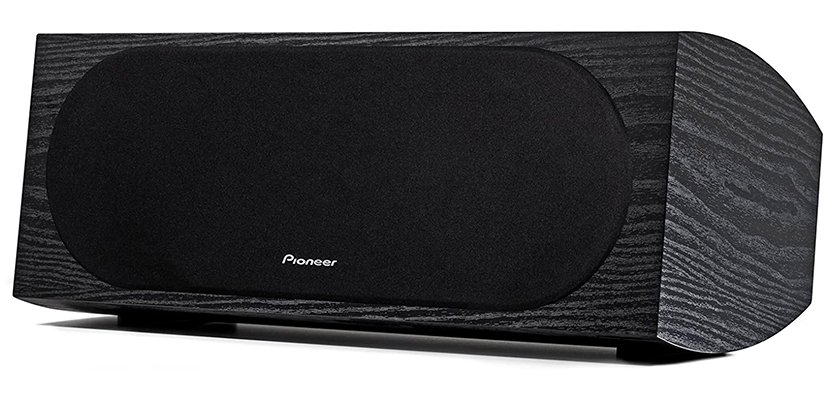
There are three basic elements inside the Pioneer SP-C22 body frame – one 1-inch tweeter and two 4-inch woofers. Despite being rather small, the woofers actually have low bass. This horizontal style speaker is compact with a dark natural wood finish. Its curved design diminishes the standing sound waves in the body frame that leads to clear sound getting. The Pioneer passive dynamics are magnetically shielded, so the speaker has additional dust and damage protection. This 6-Ohm speaker is rather high, so make sure that it does not block the TV remote control sensor.
This 2-way center speaker has the ability to lower the frequency to 55Hz and reach the 20kHz. Such a peculiarity helps bridge the sound gap between the center and surround speakers. Moreover, the sensitivity of the Pioneer SP-C22 is only 88dB, which requires less power to operate and provide better sound quality. The device is supplemented by 2 rear side wire connections, but the wires themselves have to be purchased separately. Probably, the unit can be called the best center channel speaker for home usage, but its low sensitivity and rated power (90W) make it difficult to pair this center speaker with other speakers outside the Pioneer series.
Pros
- Even while working on the maximum loudness, the music remains clear and without rattle.
- Complex crossover greatly combines audio (between the woofer and tweeter) and demonstrates the accurate sound.
- The vibration is barely felt during the speaker’s usage.
Cons
- The body frame shape (sharp) isn’t a good choice for wall mounting.
- The dialogs sometimes are a little bit unclear and some words are not hearable at all.
Video Pioneer SP-C22
Cerwin-Vega SL-45C
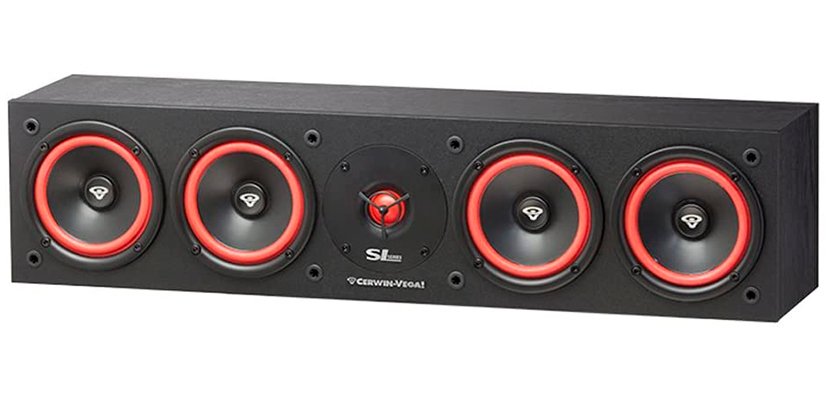
The construction contains a tweeter which is equipped with a soft dome membrane of red color. The model case is reinforced with internal struts that increase its strength and reduce unwanted resonances, providing excellent damping. An annular phase divider is installed in front of the emitter, which simultaneously performs protective functions. The characteristic feature of this 2-way model is the presence of four 5.25-inch HF/LF drivers which provide expressiveness, density, and purity of the sound, as well as a good reserve for bass. It allows the Cerwin-Vega SL-45C to accurately convey dialogs, as well as off-screen music and frontal sound special effects.
There are two high-quality screw terminals for the speaker cable connecting. A neat, removable grill helps protect the speaker from damage and dust. The model also can boast with the reliable magnetic shielding. It’s designed for a maximum power of 300W and has an impedance of 8 Ohms, which ensures its compatibility with most amplifiers and receivers. The frequency range is between 55Hz and 26kHz that makes it easy to get a clear and realistic sound.
Pros
- It can be easily paired with almost any available amplifier.
- The configuration settings allow performing the adjusting based on the room dimensions.
- This model has a neutral and dynamic midrange and provides a sound with a high degree of detail.
Cons
- Additional equalization is required in order to get a decent sound.
- The sound becomes much louder during the commercials.
Video Cerwin-Vega SL-45C
Klipsch R-25C
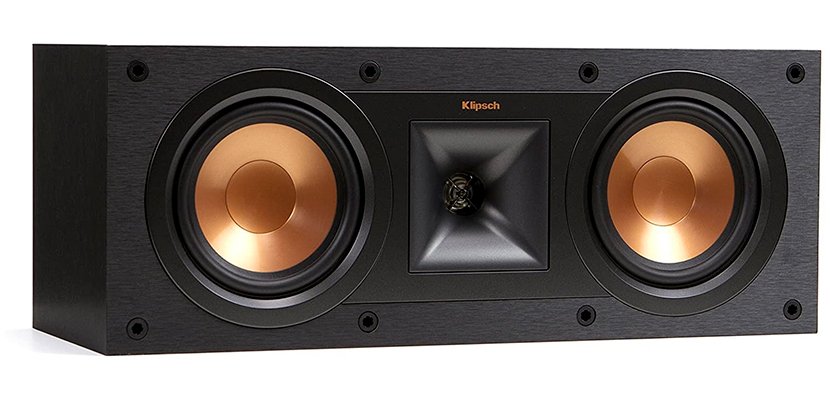
The Klipsch center speaker has low-frequency emitters with copper-coated diffusers. This coating not only gives the acoustics a recognizable appearance (a combination of the black color of the front panel and the golden membrane) but also additionally dampens the membrane to absorb resonances. The body frame doesn’t have the mounting brackets, so it might be hard to hang it on the wall. This unit uses a Tractrix horn and aluminum tweeter (LTS), which provide an impressively clear and natural high-end sound. The Injection Molded woofer with graphite impregnation is responsible for the sound in the low-frequency range. Different center channel speaker reviews demonstrate that the Klipsch R-25C frequency response differs from other models (67Hz – 24kHz), so users may evaluate how wide the directivity of the unit sound can be. Its high sensitivity (96dB) and 8-Ohm impedance create the conditions for loud music playing. At the same time, there are some almost unnoticeable distortions at the high volume level. The Klipsch R-25C delivers mid-range clarity, solid, and articulate bass. The unit is made using the same emitters as the rest of the Klipsch speakers and is fully consistent with them in sound.
Pros
- Dual 5-way binding posts demonstrate all the positive peculiarities of bi-wiring and bi-amping.
- It’s an important singularity that the model is able to fill with the sound medium (100-200 sq. ft) and large rooms (200-400 sq. ft).
- The unit’s matte polymer coating protects the center speaker from small scratches.
Cons
- The heavy bass isn’t loud enough and the device shakes while playing at the maximum loudness.
- The action scenes are accompanied by the muddy sound.
Video Klipsch R-25C
Yamaha NS-C210BL
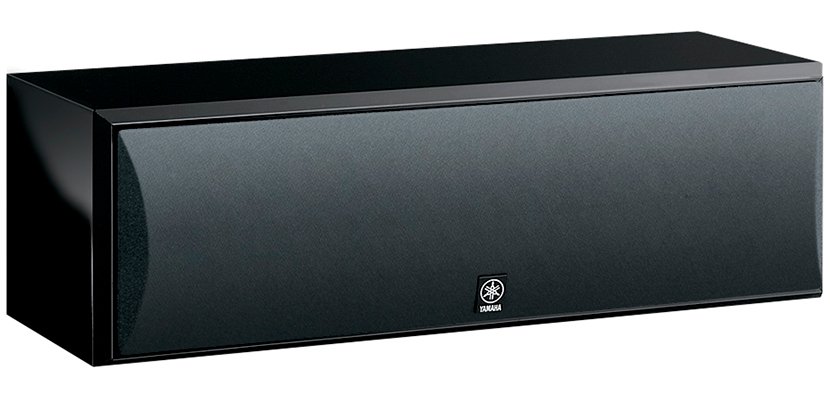
The Yamaha NS-C210BL is constructed with modern aluminum woofer, which provides the whole system with an extra response. Inbuilt balanced dome tweeter allows getting sound from HD sources. Such an element is characterized by an extended operating frequency range and a detailed sound without audible distortion. The device isn’t a self-powered one, so it does not have its own power plug. The user has to connect it to a receiver for a required sound getting. Its frequency response is really impressive (65Hz – 45kHz), so the produced sound can not only be heard but also felt (due to the sound waves). Its sensitivity (86dB) and 6-Ohm impedance level make this speaker a good addition to any modern high-end amplifier and AV receiver. The device can be called in-wall center channel speaker as it can be easily mounted via the keyhole type brackets as it weighs only 4.4 pounds being a rather light unit.
Pros
- The tuning takes not much time (it can be performed intuitively) and it’s easy to get the required sound quality.
- All the dialogs are clear and crisp, even whispering sounds loud enough to hear everything.
- It can be easily placed on the Blu-Ray player (or any other multimedia device) as it doesn’t get hot.
Cons
- The center speaker turns off for no reason.
- I can feel the vibration that appears at high volume.
Definitive Technology Procenter 1000
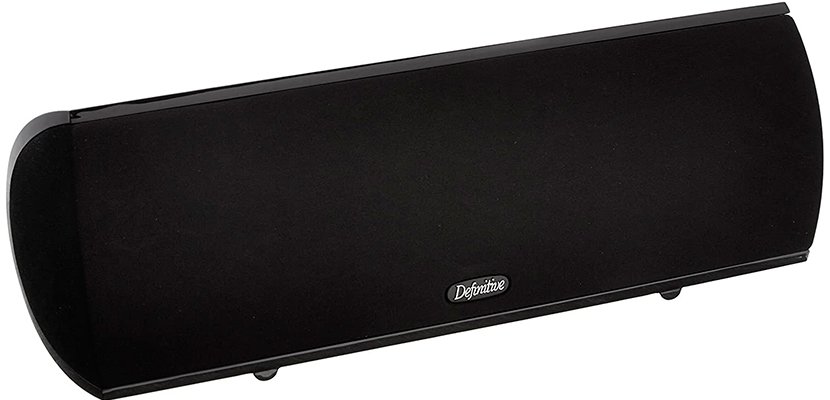
This small center channel speaker has a body frame made of a rigid and durable anti-resonant composite material PolyStone. Its smooth lines help reduce the influence of reflected sound waves, as well as standing spurious waves inside the case. There are a couple of terminals for connecting cables and wall mount on the rear side, due to which the Procenter 1000 can be mounted, for example, under a TV. The loudspeaker has a removable grill that protects the device from dust. Drivers are made using exclusive BDSS technology that gives true pleasure from the clear high-definition sound. Such a technology doubles the lower-midrange/bass radiating area and doesn’t increase the enclosure size. This passive 2-way Definitive Technology center channel speaker allows you to listen to the sound in the frequency range from 47Hz to 30kHz which helps get the full variety of sound. Its maximal impedance is 8 Ohms, but the minimal index is 4 Ohms.
Pros
- The unit minimizes the harmful vibrations of the diffuser and makes the sound clearer, more accurate, and pure.
- When placing the model on a shelf, its tilt can be adjusted via a special leg located on the back.
- The main drivers are 4.5-inch mid/bass radiators with diffusers made of reliable polymer.
Cons
- The wall-mounting is possible, but you have to purchase a special ProMount 80 bracket.
- The high sounds are not really clear and some creaky noise can be heard.
Klipsch RP-250C
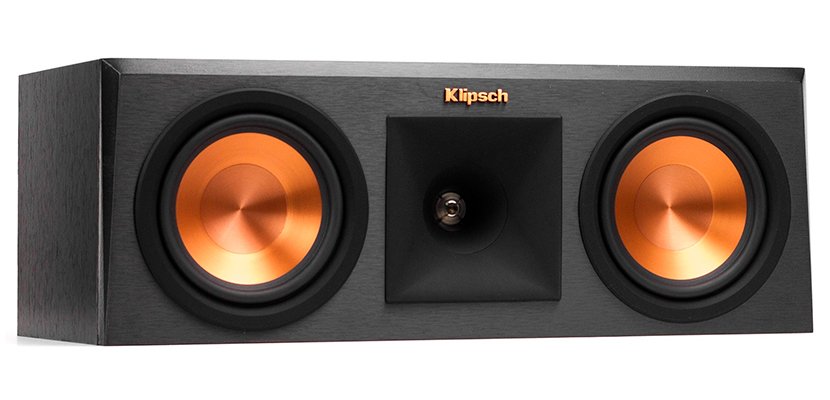
The RP-250C goes well with both floor-mounted and shelf-mounted speakers. It has an advanced 90×90 Tractrix horn, which consists of a circular throat and a square horn mouth, which makes it possible to expand the high-frequency spectrum and improve the quality of sound transmission. Due to the design of the rubber polymer created by injection molding, the channel speaker significantly reduces the noise level and improves the high-frequency spectrum. The dual 5.25-inch cerametallic cone woofers together with the Linear Travel Suspension tweeter reduce the distortion level and enable the capacity to listen to high notes without any hints of the noise or creak. The model has a fairly wide frequency range (67Hz – 24kHz). Its sensitivity is 96dB and the impedance is 8 Ohms. All these peculiarities allow the unit to demonstrate an open, clean, and natural sound with high resolution and attention to detail. It greatly reproduces dialogs, which in its performance are distinguished by intelligibility and accuracy.
Pros
- The unit fully demonstrates all the Dolby Atmos sound advantages.
- Its MDF cabinet is covered with veneer baffled finish and becomes the stylish addition to the interior.
- Removable magnet grill is flexible and withstands considerable loads.
Cons
- I can feel the vibration while the speaker performing.
- Its assembly quality isn’t really good as the Klipsch logo detaches from the body frame.
Video Klipsch RP-250C
Buyer’s Guide
What Technical Specifications to Consider Choosing a Center Channel Speaker?
Compatibility
It’s important to select the center channel speakers that are fully compatible with available multimedia elements. The right choice allows the sound to move from one speaker to another smoothly and without quality loss. You won’t hear the difference between sounds that come out from the units. It’s recommended to give preference to the basic speakers and center channel element from the same manufacturer. The item series also is important so pay attention to this moment and contact customer service in order to get the required information.
Don’t forget about the size of the mid-low speakers of the available pair: the center channel speaker should be as close as possible in size. For example, it is more preferable to acquire a large central channel for a large floor or shelf pair. Of course, the next logical parameter is the dimensions of the speaker: in some cases, you have to compromise on so that the speakers do not block the TV screen due to its big body frame. The color compatibility is also an essential parameter, so some manufacturers produce the central channel speakers in only one color (most often in black).
Configuration Ratio
Buyers may pay attention to those ratios like 3:1, 5:1, 6:1, or 7:1. These digits instruct you about the configuration of your surround sound system. The first figure designates the surround sound speakers, while the second one – the number of subwoofers. The 5:1 is regarded as the most widespread and primary format. Such systems usually are supplemented with five basic speakers and one subwoofer that’s enough to hear all the sounds correctly and loud enough. 6:1-channel systems have the additional back surround channel that provides the user with a smooth sound flow. Units with a 7:1 configuration ratio can provide the user with a true surround-sound format.
Bi-wire Capability
Be-wiring can be perceived as a way to hook up the speaker and audio amplifier. Usually, only one cable is used for this purpose, but bi-wiring requires two wires for each loudspeaker. One is used for the tweeter and the second – for bass (both of them are hooked up to the same amplifier). Thus, the signal to the high and low-frequency sections of the speaker is fed through two separate wires, which, reduce the interference between them and improve the sound quality. Some audio enthusiasts are sure that bi-wiring speakers can significantly improve the middle range sound. As a result, such items not only make the music crisper but also allow distinguishing the human voices without muffling and grating noise. It’s better to use specialized bi-wiring cables. If this is not possible, then you should use the thickest copper cable for the low-frequency part and the silver-plated if you want to emphasize the high frequencies.
As bi-wiring requires two wires for each loudspeaker, it’s better not to hang it on the wall (the wires can spoil the interior) but choose the center channel speaker mount for stand alone. Be sure to use the rack that supports the weight of the unit.
Crossover Frequency
The crossover frequency implies the action when the signal is detached into various portions and sent to the available speakers where it is transformed into a sound. Its division and distribution are performed according to the frequencies.
- Signals with higher frequency are dispensed to the tweeter.
- Signals with lower frequency are dispatched to the woofer.
- Signals with middle frequency are sent to mid-range speakers.
Pay attention that the middle and high frequencies carry the maximum information, responsible for the data of the stereo effect and sound stage. They are very susceptible to intermodulation and harmonic distortion (in a case of incorrect crossover frequency). The depth of the achieved acoustic effect depends on crossover frequency. In some cases, a high bass creates a softer sound, for example, when listening to music or watching movies that don’t contain visual or sound effects. If a more serious impact on the viewer is required (when buildings destroying or planets exploding are displayed), then the crossover frequency of the center channel speaker can be shifted closer to the low bass.
Frequency Response
The frequency response helps describe the audible frequency range that a speaker is able to reproduce. When the frequency response characteristic is poor, all other features of the speaker automatically reduce their value and do not have an essential effect on sound quality. The unit with good frequency response correctly reproduces all low, medium, and high frequencies in the right proportions. This is what allows devices to sound rich and have the required hi-end sound. Theoretically, a person hears a sound in the range from 20Hz (low frequencies) to 20kHz (high frequencies). The reality is that only women have a chance to hear especially high sounds, while men are unlikely to hear a signal above 13Hz – 14kHz.
Frequencies at the lower end of this range are well-known as bass, the higher end is well-known as treble, and the ones in the middle are mid-range. In the ideal case, the speaker is able to reproduce the sound on the same level of loudness. Indeed, most modern center channel speakers include tweeters (for high frequencies) and woofers (for low frequencies). Each of these elements has its own vibration level. The light tweeters in small units oscillate at higher frequencies when bigger and heavier woofers can wobble at lower frequencies.

Hi everyone! I’m Thomas Moody, also known as Guitarzan.
